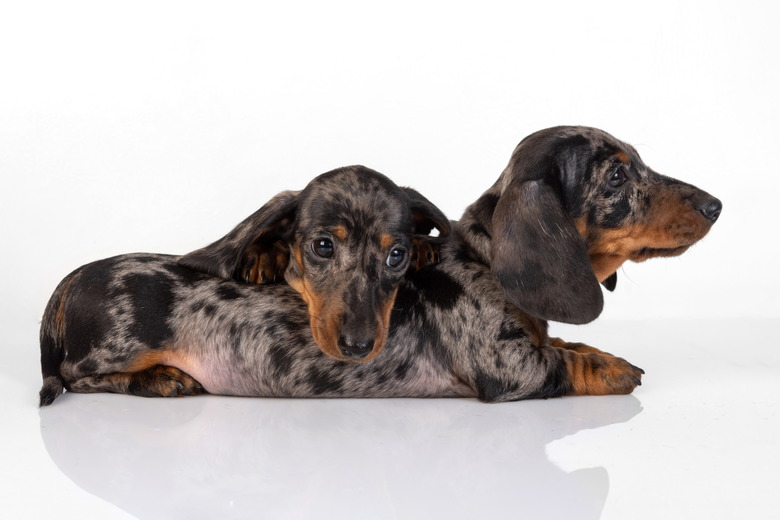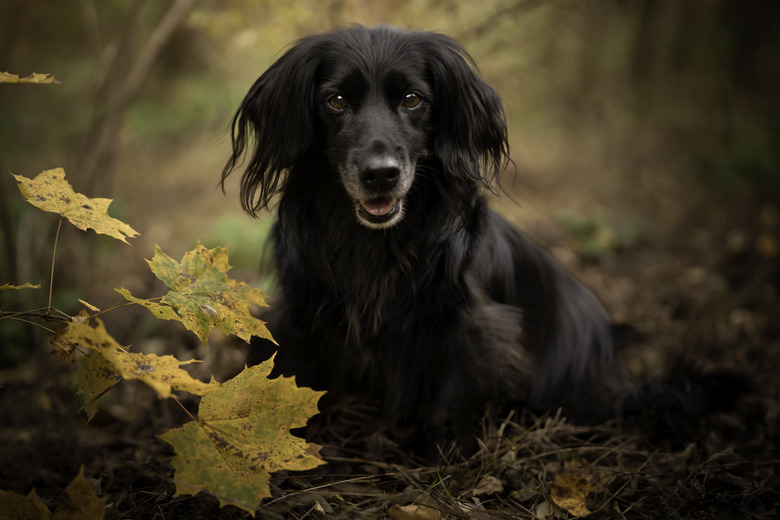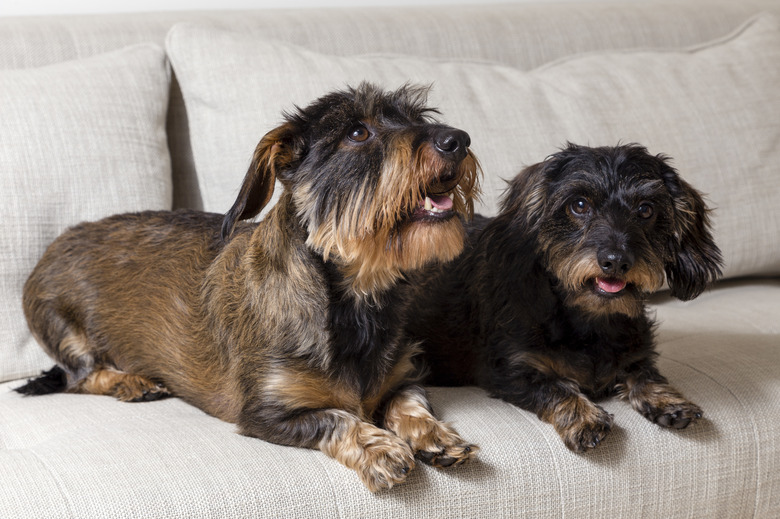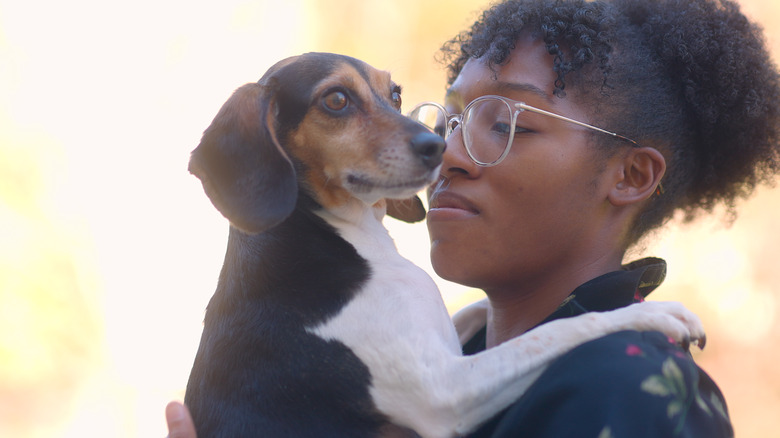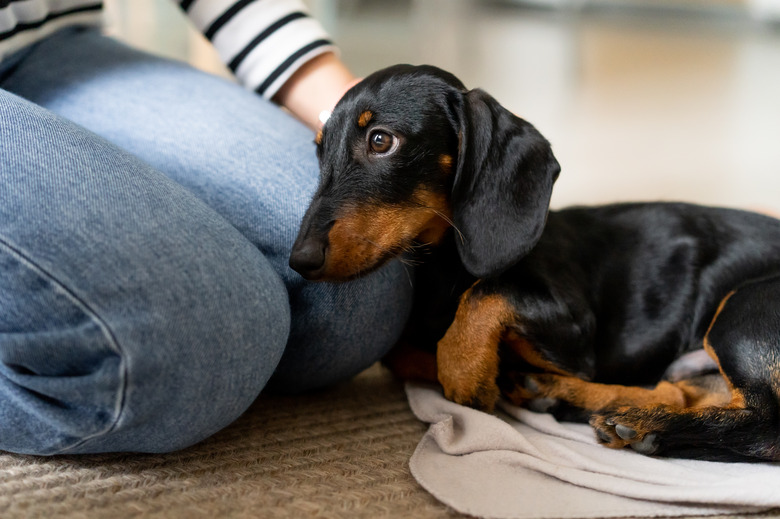Dachshund Hair Loss
Dachshunds (meaning "badger dog") aren't heavy shedders, but some amount of hair loss is normal for the three different coat types of the breed. The smooth-haired dachshund has a single coat that sheds year-round, but due to the small size of the hair, it's not as noticeable. The long-haired and wire-haired doxies have a double coat. The outer coat doesn't shed much, but twice a year, they blow their undercoat.
Losing large amounts of hair with no regrowth or hair falling out in patches isn't the norm for any doxie. If your wiener dog starts to go bald, your veterinarian needs to determine the cause. Dachshund hair loss may simply be cosmetic, or it can indicate a serious medical condition.
How much do dachshunds shed?
How much do dachshunds shed?
Compared to other dog breeds, dachshunds are light to moderate shedders overall. Both standard and miniature dachshunds come in three types of coats: smooth-haired, long-haired, and wire-haired. The type of dachshund you have will determine how much shedding you can expect.
Smooth-haired dachshunds
Sometimes called a short-haired dachshund or smooth-coated dachshund, this variety has a light to moderate amount of shedding. Brush them once a week with a soft-bristle brush to remove loose hair and dander. Due to their short coats, smooth-haired dachshunds who live in cold climates may need a winter jacket to help maintain their body temperature while outside.
Long-haired dachshunds
Since the shed hairs of this variety of dachshund are longer than their smooth-coated counterparts, it may appear that they shed more, but they shed their outer coat about the same amount. However, twice a year in spring and fall, they experience seasonal shedding of dead hair and undercoat. During this time, you can expect your dog's shedding to be heavy.
Long-haired dachshunds also require daily brushing with a slicker brush. These are easily found in pet supply stores and on Amazon. If you get a dachshund puppy, get them used to being brushed early so it's easier for you to maintain their healthy coat. Since a longer dog coat is more prone to tangles, establishing a regular grooming routine can help prevent your pup from developing mats. Take your long-haired doxie to a professional groomer every few months for a trim and also while they are blowing their undercoat.
Wire-haired dachshunds
Despite the thick undercoat, this variety's outer coat sheds less than the other two coat varieties. There are different types of wire-haired coats, ranging from fluffy to coarse. Like the long-haired doxies, fluffy wire-hairs experience seasonal shedding twice a year, and they need to visit a groomer to strip their undercoat.
Coarse wire-hairs don't need to have their coat stripped, and they are overall low-shedding dogs. Brushing should be done two to three times a week. They should also visit a groomer every few months for a trim.
Are dachshunds hypoallergenic?
Are dachshunds hypoallergenic?
Dachshunds are not hypoallergenic. However, since they are smaller and have less to shed, some may view them as less allergenic. Keep in mind, though, that there is no truly hypoallergenic dog breed. All canines have some amount of dander, which is one of the causes of people having allergic reactions to dogs.
Why is my dachshund shedding so much?
Why is my dachshund shedding so much?
There are various medical conditions that can cause a dachshund to experience excessive shedding. The most common are listed below. If your dog is losing more fur or hair than usual, especially if it's in patches, take them to your veterinarian to be examined.
Pinnal alopecia
Doxies are prone to pinnal alopecia, which is balding on the ears. Hair loss usually begins on the outer ears around 6 months to 3 years of age. The rest of the haircoat stays normal.
Pattern baldness
Dogs with this condition start to lose fur on their ears, neck, and underside at around 6 months of age. The baldness eventually spreads over all or most of the body. Within a year, the affected dog's hair is virtually gone, and the dog's skin will darken completely or in patches.
Although it's tough to see your dog go bald, the good news is that hair loss is the only symptom. Your doxie shouldn't develop conditions common in other types of hair loss, including infections, itching, or rashes.
Acanthosis nigricans
Acanthosis nigricans is another disorder of dachshunds, appearing by the dog's first birthday. While acanthosis nigricans refers to skin darkening, it's not the same affliction as the darkening in pinnal alopecia. If you're lucky, the condition remains primarily cosmetic, but it can also develop secondary to skin infections or an underlying health condition. While there's no cure for cosmetic acanthosis nigricans, topical, oral, or injectable medications can be prescribed for treatment of sores on your dog's skin.
Color dilution alopecia
Dachshunds of certain shades are prone to color dilution alopecia, which is genetic hair loss that mainly occurs in blue and fawn coats. With this condition, the hair follicles atrophy, mainly on the torso. It starts in puppyhood, and by the time they're 3 years old — and probably earlier — much of that hair is gone. While not all "dilute" dachshunds are affected, the condition is quite common.
Besides hair loss and thinning, your dog may suffer from secondary skin infections. Their health isn't otherwise affected. Your veterinarian can prescribe antibacterial shampoos to minimize infections and may recommend omega-3 fatty acid supplements and special dog foods that support skin health.
Hair loss and disease
Hair loss may indicate that your pet is suffering from an underlying disease, usually endocrine-related. In doxies, the primary culprits are hypothyroidism and Cushing's disease. Both of these afflictions occur more often in older dogs.
Hypothyroidism results from lack of sufficient thyroid hormone production by your doxie's thyroid glands, located in their neck. These glands regulate much of your dog's metabolism. Besides hair loss, other symptoms include:
- Frequent skin infections
- Weight gain
- Lethargy
- Cold intolerance
- Scaly skin
Via blood, urine, and other tests, your veterinarian can determine whether your dog's thyroid hormone levels are deficient. Fortunately, a thyroid pill given twice a day for the rest of your dog's life usually manages the problem. Their hair should eventually grow back.
Cushing's disease, or hyperadrenocorticism, results from excessive amounts of cortisol hormone in your doxie's bloodstream. Other symptoms include:
- Increased drinking and urination
- Constant hunger
- Insomnia
- Development of a pot belly
- Muscle weakness
- Frequent panting
Your veterinarian will conduct blood and sometimes urine tests to determine if your pet has Cushing's. Approximately 85 percent of dogs with Cushing's disease have a small, benign growth in a part of their brain called the pituitary gland. They are treated with medication for the rest of their life. About 15 percent of the time, the disease is caused by a benign or malignant tumor on the adrenal gland. These dogs are better managed with surgical removal of the growth.
The bottom line
The bottom line
All dachshunds shed to some degree, but compared to other dog breeds, they are low shedders overall. The exceptions are doxies with medical conditions that cause hair loss or when long-haired doxies and fluffier wire-hairs go through seasonal shedding. During this time, your sausage dog's grooming needs will increase, and they will need to have their undercoat stripped. Some dachshund owners learn how to do this, but if you're unsure how to handle this more complex grooming task, take your dog to a professional groomer. Short-haired dachshunds can be brushed once a week, but a long-haired dachshund's coat needs regular brushing. Wire-hairs should be brushed a few times a week.
